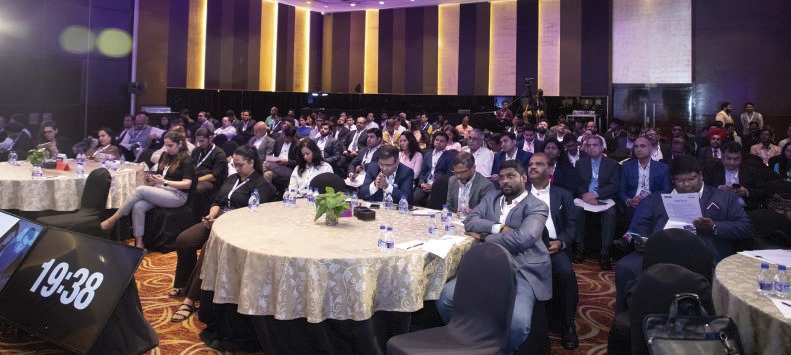A revealing panel discussion at Technoviti 2023 organized by Banking Frontiers:

Panelists:
Nirav Parekh, EVP & Head – Strategic Initiatives, Agri Business Group, Kotak Mahindra Bank
Vaibhav Bansal, Product Lead – Warehouse Commodity Finance, HDFC Bank
Kapil Dev, Chief Business Officer, NCDEX
Pushan Sharma, Director, CRISIL
Amit Salunkhe, Head – Sales, SatSure Sage
Pradeep Singh, Head – Compliance & Strategy, Netafim Agricultural Financing Agency (NAFA)
Alok Shukla, Regional Head – Agriculture, Munich Re (Moderator)
Alok Shukla: The speed with which the technology is progressing is a driver for transformation and disrupting lives. We have satellites which have resolution even a few meters. How do you see satellite imagery disrupting the lending sector? Are we are moving towards farm level underwriting with the technology?
Nirav Parekh: The current situation is that banking is already on a run with fintechs taking over everywhere. Agriculture is a space where banks have for long been waiting to reach their customer base. So it’s a very welcome sign for banking. That’s where satellite would help.
While lenders focus on collateral, cash flow is more critical. Why banks look for collateral is because there is a lack of control on cash flow. So ideally, the moment you start getting controls on cash flows, your collateral can be done away with.
In agri, cash flow is very critical role. Satellite images will actually help understand what the crop pattern will be, what crops will grow and what realization farmers will get. This plays a very significant role in deciding the extent of lending and to derive the quality of lending over a period of time.
Since bankers can’t reach everywhere, the satellite images will be the key to go right into the countryside. Farm level assessments have already started happening. How do you build it on an AI is what is being spoken about. Most of the bankers have already started doing things where we get a complete idea of the cropping pattern at a particular farmland while sitting at our offices to then go ahead with the lending.
What is the largest thing that has grown in banking in the last 5 years? MFI has come out as one of the largest businesses and we believe that there is a huge space available in lending space in the agriculture sector. Satellite images will be a key as we go forward.
Pradeep Singh: Technology is creating the disruption. The only challenges is handling the technology in a manner that the basic essence of product is not taken away. PSL is always in the back of the mind for bankers, and that’s why you see that despite agri loan being a working capital loan, we always marketed it like a rural app because we wanted things to be easy. We can’t handle those complexities and varieties which are present on the ground.
Farmers are different across states, across districts and within a district. Earlier, we had a collective wisdom from the field. The guiding force were the relationship managers. In banking retail products, these people were called sales managers, but in agri space they were always called relationship managers. The person who has the touch and feel of the customer must have the say in the decision making for lending.
That collective wisdom was never quantifiable. We have digital technology now which can quantify and give you a lot of answers. Now it’s up to us about how the PSL achievement will take shape. Technology should never become the master in this will because it can lead it into different directions.
Alok Shukla: What exactly is this technology we are talking about and what has really changed?
Amit Salunkhe: Earth observation has been around for 2 decades. So data has been available for a very long time. SatSure realized that what is more important than the data is the insight.
KCC is something that every bank has to do. For the banker who is sitting in a branch, disbursing a Rs1 million loan in 10 minutes is much easier than disbursing a KCC, which takes approximately 45 days. Understanding that gap was equally critical on top of getting information and insights. Marrying these two insights was very important for us. That’s where we created this differentiation. Today, an underwriter sitting within his office can look into our platform, identify the land parcel which is of interest and generate an alternative dataset from a capacity perspective.
For a very long time, banks have been lending these farmers basis the intent. It was easy to look at a CIBIL score and decide whether or not to lend to a farmer. But the cash flow information is missing because these farmers transact mainly in cash. While we have 150 million farmers, of whom only 80 million farmers have access to formal credit, which leaves so many who are new to credit.
Using this alternative data, which is generated by organizations like SatSure, which is the capacity data, can banks in financial institutions lend to these farmers? We are in a very early stage. We have seen our own success stories where adoptions are happening at a policy level. Now, that’s one step forward. With this technology, all the ecosystem partners have to join hands and look at this new technology and opportunity.
Alok Shukla: How can we use this technological advancement at each and every step of lending and how we can create more efficiencies and better customer service around it?
Kapil Dev: NCDEX is the largest agri exchange of the country having 95% market share. Taking technology to the farmers and bringing transparency has been core of our operations, because we do understand that to connect the rural market to the mainstream financial market can happen only through technology. Also, not the technology that we use, but what they use. In agriculture, mostly what we see is the unsecured loan because you don’t know the income of the farmers.
Two decades back we were the first to come up with the online platform for agriculture trading and also the first to have an online spot market for agriculture trading. We were the first to start demat of agricultural commodities, now called eNWR.
In agricultural sector, we are trying to bridge the gap of assuring farmer income using derivatives market. Satellites are definitely a good tool to have to understand the farmer, but end of the day, it has to conclude what will happen to crop and farmer income if there is El Nino this year, and so on? What is going to happen to the crop which is there?
The entire formal lending is around Rs400-500 billion while the entire production is around Rs20 trillion. I think the lending is going to change in a very aggressive way and it is going to happen soon.
Alok Shukla: How exactly is technology expected to disrupt the post-harvest lending space and then how we can look at more digitization and how it will help the whole agri-fin sector.
Vaibhav Bansal: Agri is also very complex and from a lending perspective, we always explore how to mitigate the risk. In post-harvest finance, which is 15-17 years old now, there are storage risks and commodity risks. Each and every load which comes into the warehouse, has its own variety and commodity parameters. And as a lender you have to arrive at a value and confirm to the borrower. So technology is the answer to all these risks.
At the end of the day, all the value chain participants need instant money, and we have been able to reduce this from 8 hours to 15 minutes. You need 3 things to make a change – a vision, a challenge and an attitude. But during the change, we come across objectivity issues and even the best minds tend to lose their objectivity in the pursuit of excellence. This becomes a barrier to reach that objective. Digitization of warehouses and commodities is the only answer. Technology is creating a disruption in the space.
Alok Shukla: A very important aspect of any business is a human touch, particularly when we go to rural sector. So as we are moving more towards technology driven solutions, how do you see thing shaping up? Is there still is a requirement of human touch between us as a service provider and the customer?
 Pradeep Singh: We never use the term sales manager because at the farmer level, the person who gives money to the farmer has the right to collect it back because farmer doesn’t understand anyone nor any institution. He only talks to the human face which he is interacting with. So technology-wise, the farmer has upgraded himself, he has made himself aware and is comfortable using something, but not everything because he doesn’t understand technology.
Pradeep Singh: We never use the term sales manager because at the farmer level, the person who gives money to the farmer has the right to collect it back because farmer doesn’t understand anyone nor any institution. He only talks to the human face which he is interacting with. So technology-wise, the farmer has upgraded himself, he has made himself aware and is comfortable using something, but not everything because he doesn’t understand technology.
So even a farmer who’s ready to use WhatsApp and is very prominent on Facebook, is not ready to click a link to digitally sign the loan agreement because he’s scared. He doesn’t know what will happen. He has read stories about that the entire account has been wiped off. So this is a client who needs special attention. He still prefers a personal touch. He would rather to argue with the person sitting in front of him saying about an incorrectly debited or credit, but he’s not comfortable doing that with machine. He doesn’t trust it.
So, in this area we always have to maintain that human touch. Those touch points obviously have to be cost efficient because of the size we cannot have those many people. It has to remain phygital with some physical presence where a person can talk to a human being.
Vaibhav Bansal: We are just changing the roles. Human beings will be doing the monitoring job, for which you will replace with the AI with the human. If that is missed, it will become a mess.
Nirav Parekh: I have a slightly different view. I think the farmer is changing faster than we are changing – the adaptability, the smartphone penetration, the WhatsApp adoption, that is rapidly happening today at the ground level. We need to build that level of trust. They have that ability and are agile. We believe they will do banking digitally. They will get the benefit of the loans touching right up to their doorsteps, but from a technological platform. The challenge for us is to only build that level of trust – that what you are doing is in your benefit, and over a period, this is going to benefit the entire ecosystem.
Kapil Dev: In 2000, I heard that Rs920 billion is the post-harvest loss in agriculture. Now in 2023, the numbers have not changed. We have been talking about warehouse efficiency. India needs warehouses, but the warehousing industry is struggling to get the right amount of business. It is getting around 85 million tons against 300 million tons that we produce. So we need to connect the dots between NBFCs, banks, exchanges, warehouse service providers, other service providers and others to grow the whole and not just their individual parts.
Alok Shukla: With these changes in the technology, how do you see the acceleration towards our financial inclusion objectives and what threats do you see?
Phushan Sharma: A large segment of our society where credit penetration is not where it should be. We’ve got about 150 million land holding. The credit penetration on the formal side is only 60%, reaching out to about 80-90 million farmers. The average landholding is just about one hectare. A farm family in India earns around 1.2-1.5 lakh per annum, and that’s for a family of five.
So it is very important that they have access to credit at a reasonable rate and only about 90 million have that rate. When they go to the moneylenders, the interest rates could be as high as 36% and their entire life goes in paying the interest. Which is why the RBI is mandating increase in access to capital to these people. RBI says there are about 200 districts in India which have less than Rs6000 per capital credit, whereas they’re another 200 which have more than 25,000 per capita credit.
And if one lends to the former category, the incentive is that you get 25% more credit in meeting your PSL targets. This is where satellite imagery comes into play. What satellite imagery really does is it just puts all the farmers on the same playing field and the banker does not have to go physically assess what really the farmer is growing, does he have access to irrigation, is he using farm equipment, what sort of yields does he have, etc. Satellite imagery helps us understand which other pockets have a similar risk profile, which have similar opportunities, etc.
Similarly on risk, a lender can use satellite images to get advance signals about risks. Crisil is in advanced stages of developing risk assessment models to put all the farmers on a level playing field so that banks that are able to assess the risks and opportunities in a more dynamic manner.
What this does is it reduces the information asymmetry in the entire system. Misinformation can lead to a sharp escalation in prices. And this is a gap that satellite imagery can plug by looking at what the real damage is. It brings us closer to the reality though it may not be 100% accurate.
Read More:








